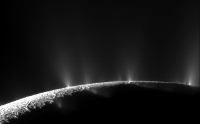Cassini Scientist for a day competition 2016-2017: Targets
Which of these targets do you choose?
1. Ice plumes at the south pole of Enceladus
 |
| Target 1. Ice plumes at the south pole of Enceladus. Credit: NASA/JPL/Space Science Institute. |
Enceladus is the sixth-largest moon of Saturn, and is about 500 km in diameter. With its white, icy surface reflecting nearly 100% of the sunlight that reaches it, Enceladus is one of the brightest worlds in the Solar System. William Herschel discovered Enceladus in 1789, but little was known about it until the two Voyager spacecraft flew past in the 1980s.
In 2005, the Cassini mission provided the first ever view of Enceladus’ south pole. There, plumes of ice and water vapour were discovered, jetting out from cracks in its surface. Due to their appearance these long cracks are nicknamed ‘tiger strips’. Some of the material found gushing out of Enceladus falls back down to the surface and some escapes, spreading particles throughout the E-ring of Saturn’s ring system. The source of the spouting material is thought to be an ocean, beneath the moon’s icy crust.
To find out more about this target view the information on the NASA 'Cassini Scientist for a Day' competition pages.
2. The lakes of Titan
.jpg) |
| Target 2. The lakes of Titan. Credit: NASA/JPL/Space Science Institute. |
Titan is the largest moon of Saturn, the second largest in the Solar System (after Ganymede of Jupiter). It was discovered by Christiaan Huygens in 1655. It is the only moon in the Solar System known to have clouds and a thick, planet-like atmosphere.
It is also the only place in the Solar System known to have an Earth-like cycle of liquids flowing across its surface. However, it is very cold on Titan (around -179 degrees Celsius) due to its great distance from the Sun. This means that on Titan water plays the role of rock and volcanoes have water as lava, and ethane and methane can exist as flowing liquids on the surface carving river channels and lakes. These liquids form clouds from which the liquid gases sometimes rain from the sky as water does on Earth.
To find out more about this target view the information on the NASA 'Cassini Scientist for a Day' competition pages.
3. The hexagon at Saturn's north pole
 |
| Target 3. The hexagon at Saturn's north pole. Credit: NASA/JPL/Space Science Institute. |
Saturn has been known since antiquity. It is the second largest planet in the Solar System and is famous for its stunning ring system. Saturn is known as a gas giant, mostly made up of hydrogen and helium. It has no distinct boundary between its atmosphere and deeper layers of liquid and solid forms of these gases.
This planet is one of the windiest places in the Solar System, and wind speeds have been clocked at a staggering 1800 kilometres per hour at the equator. Occasionally, violent storms break through the cloud layers, and can be bigger than Earth. When NASA’s Voyager 2 spacecraft flew past Saturn in 1981 it observed a hexagonal band of clouds surrounding the planet’s north pole. This hexagon shape is a jet stream – a fast flowing, narrow, meandering air current that is wide enough to fit almost four Earth’s inside.
When Cassini viewed this region of Saturn it found that this curious band of clouds surrounds an extensive and powerful hurricane centred on Saturn's north pole.
To find out more about this target view the information on the NASA 'Cassini Scientist for a Day' competition pages.
